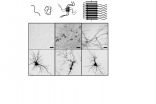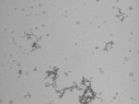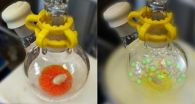(Press-News.org) The peptide —a small protein— beta-amyloid is strongly associated with Alzheimer's disease; however, researchers are still looking for unequivocal proof that this peptide is the causal agent of the onset and development of the disease. The main obstacle impeding such confirmation is that beta-amyloid is not harmful when found in isolation but only when it aggregates, that is when it self-assembles to form the so-called amyloid fibrils
"We are not dealing with a single target, beta-amyloid alone, but with multiple ones because each aggregate of peptide, which can go from two units to 3,000 is a potential target. Determining the aggregate responsible for neuronal death is extremely complex and is one of the key issues for confirming or rejecting the hypothesis regarding beta-amyloid," explains Natàlia Carulla, scientist at the Institute for Research in Biomedicine (IRB Barcelona) and principal investigator of the study published today in the scientific journal ACS Chemical Biology. In their latest work, Carulla and collaborators describe a technique that has allowed them, for the first time, to distinguish different types of beta-amyloid aggregates formed during aggregation and in parallel to establish which is most toxic. The study provides further evidence in support of the hypothesis that neuronal death is caused by intermediate aggregates of beta-amyloid and reveals that the development of structure within these aggregates determines their ability to cause neuronal death.
The Harmful Forms of Beta-Amyloid
The study shows that the most toxic aggregates are those formed by 20 to 100 units of beta-amyloid, known as intermediate aggregates or precursor aggregates of beta-amyloid fibrils. In contrast, the smaller aggregates of beta-amyloid and the amyloid fibrils, which can contain up to 3,000 units of the peptide, do not cause neuronal death.
The scientists treated cultures of mouse neurons with samples obtained at different times of the aggregation process. The point at which they observed the highest neuronal death, reaching about 60%, occurred when cells were exposed to intermediate aggregates of beta-amyloid that had developed a certain degree of structure. The experiments with mouse neurons were performed in collaboration with Eduardo Soriano's team at the University of Barcelona, they prepared neuronal cultures from the hippocampus, the brain region in which neuronal lost is first observed in Alzheimer's disease.
"The technique that we have set up allows us to detect how the structure within these aggregates increases, that is to say, how the aggregates take shape and how they get organized. We observed that maximum toxicity occurs when they have acquired a given degree of structure, a certain rigid part in the aggregate," explains Carulla.
The scientists uphold that this is precisely one of the most promising results of the study presented today. "We can see structure, organization and common pattern and therefore the hope is that if we manage to characterize this pattern, we will be able to look for and design therapeutic molecules that prevent their formation or cause their disruption" says first author of the article Bernat Serra-Vidal, whose PhD thesis was based on this work.
Furthermore, the researchers explain that the tools developed to study beta-amyloid aggregation could be used to examine the aggregation of other proteins that are associated with conditions such as Parkinson's disease, Huntington's disease, and type 2 diabetes.
INFORMATION:
Reference Article
Hydrogen/Deuterium Exchange-Protected Oligomers Populated during Aβ Fibril Formation Correlate with Neuronal Cell Death
Bernat Serra-Vidal, Lluís Pujadas, Daniela Rossi, Eduardo Soriano, Sergio Madurga,and Natàlia Carulla
ACS Chem. Biol. (2014): dx.doi.org/ 10.1021/cb500621x
Institute for Research in Biomedicine (IRB Barcelona)
Founded in 2005 by the Government of Catalonia and the University of Barcelona, the Institute for Research in Biomedicine (IRB Barcelona) is "Severo Ochoa Centre of Excellence", since 2011. The 23 groups hosted by the institute are devoted to basic and applied research at the interface between molecular and cellular biology, structural and computational biology, and chemistry, with experts in proteomics, genomics, biostatistics, and advanced digital microscopy. The research at IRB Barcelona is organised into five programmes, which work together with the common goal of conducting multidisciplinary projects that address important biomedical problems affecting our society, with special emphasis on cancer, metastasis, Alzheimer, diabetes and rare diseases. The institute is home to approximately 440 employees from 38 countries. IRB Barcelona's ultimate objective is to translate research results to the clinic and has already established three biotechnology spin-off companies to this end. More than 25% of its scientists receive funding from the European Research Council –seven projects. The institute is located in the Barcelona Science Park (PCB), in the Diagonal Campus of the University of Barcelona. Director: Dr. Joan J. Guinovart.
http://www.irbbarcelona.org
@IRBBarcelona
http://www.facebook.com/irbbarcelona
Laying siege to beta-amyloid, the key protein in Alzheimer's disease
IRB Barcelona scientists observe that aggregates of 20 to 100 units of beta-amyloid have a structure that is the most harmful to neurons
2014-10-01
ELSE PRESS RELEASES FROM THIS DATE:
Changing Antarctic waters could trigger steep rise in sea levels
2014-10-01
Current changes in the ocean around Antarctica are disturbingly close to conditions 14,000 years ago that new research shows may have led to the rapid melting of Antarctic ice and an abrupt 3-4 metre rise in global sea level.
The research published in Nature Communications found that in the past, when ocean temperatures around Antarctica became more layered - with a warm layer of water below a cold surface layer - ice sheets and glaciers melted much faster than when the cool and warm layers mixed more easily.
This defined layering of temperatures is exactly what is ...
Eighty percent of bowel cancers halted with existing medicines
2014-10-01
An international team of scientists has shown that more than 80 per cent of bowel cancers could be treated with existing drugs.
The study found that medicines called 'JAK inhibitors' halted tumour growth in bowel cancers with a genetic mutation that is present in more than 80 per cent of bowel cancers. Multiple JAK inhibitors are currently used, or are in clinical trials, for diseases including rheumatoid arthritis, psoriasis, blood cancers and myeloproliferative disorders.
Bowel cancer is the second-most common cancer in Australia with nearly 17,000 people diagnosed ...
Nanoparticles accumulate quickly in wetland sediment
2014-10-01
DURHAM, N.C. -- A Duke University team has found that nanoparticles called single-walled carbon nanotubes accumulate quickly in the bottom sediments of an experimental wetland setting, an action they say could indirectly damage the aquatic food chain.
The results indicate little risk to humans ingesting the particles through drinking water, say scientists at Duke's Center for the Environmental Implications of Nanotechnology (CEINT). But the researchers warn that, based on their previous research, the tendency for the nanotubes to accumulate in sediment could indirectly ...
Robot researcher combines nature to nurture 'superhuman' navigation
2014-10-01
Computer modelling of the human eye, the brain of a rat and a robot could revolutionise advances in neuroscience and new technology, says a QUT leading robotics researcher.
Dr Michael Milford from QUT's Science and Engineering Faculty says the new study uses new computer algorithms to enable robots to navigate intelligently, unrestricted by high-density buildings or tunnels.
"This is a very Frankenstein type of project," Dr Milford said.
"It's putting two halves of a thing together because we're taking the eyes of a human and linking them up with the brain of a rat.
"A ...
Snapshots of chemical reactions: Characterizing an important reactive intermediate
2014-10-01
An international group of researchers led by Dr. Warren E. Piers (University of Calgary) and Dr. Heikki M. Tuononen (University of Jyväskylä) has been able to isolate and characterize an important chemical intermediate whose existence has, so far, only been inferred from indirect experimental evidence.
Chemical reactions rarely go from starting materials to final products in one single step, but instead they progress through a number of intermediates. In many cases the intermediates are not stable enough to be studied by conventional characterization methods, which thwarts ...
Omega-3 fatty acids may prevent some forms of depression
2014-10-01
Philadelphia, PA, October 1, 2014 – Patients with increased inflammation, including those receiving cytokines for medical treatment, have a greatly increased risk of depression. For example, a 6-month treatment course of interferon-alpha therapy for chronic hepatitis C virus infection causes depression in approximately 30% of patients.
Omega-3 fatty acids, more commonly known as fish oil, have a long list of health benefits, including lowering the risk of heart disease and reducing triglyceride levels. These nutritional compounds are also known to have anti-depressant ...
Power can corrupt even the honest
2014-10-01
When appointing a new leader, selectors base their choice on several factors and typically look for leaders with desirable characteristics such as honesty and trustworthiness. However once leaders are in power, can we trust them to exercise it in a prosocial manner?
New research published in The Leadership Quarterly looked to discover whether power corrupts leaders. Study author John Antonakis and his colleagues from the University of Lausanne explain, "We looked to examine what Lord Acton said over 100 years ago, that 'Power corrupts and absolute power corrupts absolutely.'"
To ...
Non-traditional donor lungs appear safe for transplant
2014-10-01
Chicago, October 1, 2014 – Patients receiving lungs from donors whose cause of death was asphyxiation or drowning have similar outcomes and long-term survival as patients receiving lungs from traditional donors, according to a study in the October2014 issue of the Annals of Thoracic Surgery.
Key points:
Lungs from donors whose cause of death was asphyxiation or drowning can be safely transplanted into patients with end-stage lung disease.
Patient survival rates were not affected when lungs from cases involving asphyxiation and drowning were used.
The researchers note ...
Strict blood sugar control after heart surgery may not be necessary
2014-10-01
Chicago, October 1, 2014 – Patients undergoing coronary artery bypass grafting (CABG) surgery may not have to follow a strict blood sugar management strategy after surgery, according to a study in the October 2014 issue of the Annals of Thoracic Surgery.
Key points
Liberal management of a patient's blood sugar levels following CABG surgery leads to similar survival and long-term quality of life as achieved through stricter blood sugar management.
The findings applied to all patients, regardless of diabetes status.
The results may encourage hospitals to consider ...
Child mortality falls worldwide, but not fast enough, study finds
2014-10-01
Despite advances, millions of children worldwide still die before their fifth birthday, with complications from preterm birth and pneumonia together killing nearly 2 million young children in 2013, according to a study led by the Johns Hopkins Bloomberg School of Public Health.
Their report, published online Oct. 1 in The Lancet, examines what caused an estimated 6.3 million children under the age of five to die in 2013, one-third fewer than the 9.9 million estimated to have died around the world in 2000. While preterm births and pneumonia were also the top killers in ...
LAST 30 PRESS RELEASES:
Tracing the quick synthesis of an industrially important catalyst
New software sheds light on cancer’s hidden genetic networks
UT Health San Antonio awarded $3 million in CPRIT grants to bolster cancer research and prevention efforts in South Texas
Third symposium spotlights global challenge of new contaminants in China’s fight against pollution
From straw to soil harmony: International team reveals how biochar supercharges carbon-smart farming
Myeloma: How AI is redrawing the map of cancer care
Manhattan E. Charurat, Ph.D., MHS invested as the Homer and Martha Gudelsky Distinguished Professor in Medicine at the University of Maryland School of Medicine
Insilico Medicine’s Pharma.AI Q4 Winter Launch Recap: Revolutionizing drug discovery with cutting-edge AI innovations, accelerating the path to pharmaceutical superintelligence
Nanoplastics have diet-dependent impacts on digestive system health
Brain neuron death occurs throughout life and increases with age, a natural human protein drug may halt neuron death in Alzheimer’s disease
SPIE and CLP announce the recipients of the 2025 Advanced Photonics Young Innovator Award
Lessons from the Caldor Fire’s Christmas Valley ‘Miracle’
Ant societies rose by trading individual protection for collective power
Research reveals how ancient viral DNA shapes early embryonic development
A molecular gatekeeper that controls protein synthesis
New ‘cloaking device’ concept to shield sensitive tech from magnetic fields
Researchers show impact of mountain building and climate change on alpine biodiversity
Study models the transition from Neanderthals to modern humans in Europe
University of Phoenix College of Doctoral Studies releases white paper on AI-driven skilling to reduce burnout and restore worker autonomy
AIs fail at the game of visual “telephone”
The levers for a sustainable food system
Potential changes in US homelessness by ending federal support for housing first programs
Vulnerability of large language models to prompt injection when providing medical advice
Researchers develop new system for high-energy-density, long-life, multi-electron transfer bromine-based flow batteries
Ending federal support for housing first programs could increase U.S. homelessness by 5% in one year, new JAMA study finds
New research uncovers molecular ‘safety switch’ shielding cancers from immune attack
Bacteria resisting viral infection can still sink carbon to ocean floor
Younger biological age may increase depression risk in older women during COVID-19
Bharat Innovates 2026 National Basecamp Showcases India’s Most Promising Deep-Tech Ventures
Here’s what determines whether your income level rises or falls
[Press-News.org] Laying siege to beta-amyloid, the key protein in Alzheimer's diseaseIRB Barcelona scientists observe that aggregates of 20 to 100 units of beta-amyloid have a structure that is the most harmful to neurons





